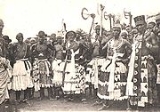
Abomey
Encyclopedia
When UNESCO designated the royal palaces of Abomey as a World Heritage Site in 1985 it stated
From 1993, 50 of the 56 bas-reliefs that formerly decorated the walls of King Glèlè
(now termed the 'Salle des Bijoux') have been located and replaced on the rebuilt structure. The bas-reliefs carry an iconographic program expressing the history and power of the Fon people.
Today, the city is of less importance, but is still popular with tourists and as a centre for crafts.
World Heritage News, the Royal Palaces of Abomey suffered from a fire on January 21, 2009, "which destroyed several buildings." The fire was the most recent disaster which has plagued the site, coming after a powerful tornado damaged the site in 1984.
- From 1625 to 1900 twelve kings succeeded one another at the head of the powerful Kingdom of Abomey. With the exception of King Akaba, who used a separate enclosure, they each had their palaces built within the same cob-wall area, in keeping with previous palaces as regards the use of space and materials. The royal palaces of Abomey are a unique reminder of this vanished kingdom.
From 1993, 50 of the 56 bas-reliefs that formerly decorated the walls of King Glèlè
Glele
Badohou, who took the throne name Glele, is considered to be the tenth King of the Aja kingdom of Dahomey . He succeeded his father, Ghezo, and ruled from 1858 to 1889....
(now termed the 'Salle des Bijoux') have been located and replaced on the rebuilt structure. The bas-reliefs carry an iconographic program expressing the history and power of the Fon people.
Today, the city is of less importance, but is still popular with tourists and as a centre for crafts.
Threats
As reported by UNESCOUNESCO
The United Nations Educational, Scientific and Cultural Organization is a specialized agency of the United Nations...
World Heritage News, the Royal Palaces of Abomey suffered from a fire on January 21, 2009, "which destroyed several buildings." The fire was the most recent disaster which has plagued the site, coming after a powerful tornado damaged the site in 1984.
Demographics
| Year | Population |
|---|---|
| 1860s | 24 000 |
| 1979 | 38 412 |
| 1992 | 65 725 |
| 2002 | 77 997 |
| 2008 (estimate) | 87 344 |

